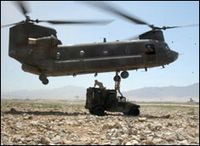CH-47 Chinook - Description and Specifications Description and Specifications: The venerable twin-engine, tandem rotor Chinook helicopter has undergone numerous upgrades since the first CH-47A model was delivered to the Army for use in Vietnam. Beginning in 1982 and ending in 1994, all CH-47A, B and C models were upgraded to the CH-47D version, which remains the U.S. Army standard and features composite rotor blades, an improved electrical system, modularized hydraulics, triple cargo hooks, avionics and communication improvements, and more powerful engines that can handle a 19,500 lb load - nearly twice the Chinook's original lift capacity. An upgrade program exists to remanufacture 300 of the current fleet of 425 CH-47D's to the CH-47F standard. The MH-47E is the Special Forces variant of the Chinook and will be remanufactured to the MH-47G.
The Chinook's cockpit accommodates two pilots and an observer. The communications suite includes jam resistant HF and UHF radio systems and the helicopter is equipped with an Identification Friend or Foe (IFF) interrogator. Three machine guns can be mounted on the helicopter, two in the crew door on the starboard side and one window-mounted on the port side. Additionally, the helicopter is equipped with a suite of countermeasure systems, which could include one or more of the following: a missile approach warner, jammers, radar warner, and chaff and flare dispensers. The Chinook has a triple hook system, which provides stability to large external loads or the capacity for multiple external loads. Large external loads such as 155mm howitzers can be transported at speeds up to 260km/h using the triple hook load configuration.
 | Mission Transport ground forces, supplies, ammunition and other battle-critical cargo in support of worldwide combat and contingency operations. Entered Army Service in 1962. Photo Credit: army.mil |
 | A new CH-47F Chinook flies over a training area on Fort Campbell, Ky., during the Aug. 15 rollout of the upgraded aircraft. Photo by Gregory Frye, August 17, 2007 |
Multiple external loads can be delivered to two or three separate destinations in one sortie. The cabin provides 42 cubic meters of cargo space and 21 square meters of cargo floor area and can accommodate two HMMWVs (High Mobility Multipurpose Wheeled Vehicle) or a HMMWV together with 105mm howitzer and gun crew. The main cabin can hold up to 33 fully-equipped troops. For medical evacuation, the cabin can accommodate 24 litters (stretchers). Ramp operations can be carried out on water using an optional power-down ramp and water dam configuration. The Chinook is equipped with two T55-GA-714A turboshaft engines, which are pod-mounted on either side of the rear pylon under the rear rotor blades. The self-sealing fuel tanks are mounted in external fairings on the sides of the fuselage. The fixed tanks hold 1,030 gallons of fuel.
Three additional fuel tanks can be carried in the cargo area. In-flight refueling can extend the range of the MH-47 helicopter. The CH-47F upgrade program involves the installation of a new digital cockpit and modifications to the airframe to reduce vibration. The upgraded cockpit will provide future growth potential and will include a digital data bus that permits installation of enhanced communications and navigation equipment for improved situational awareness, mission performance, and survivability. Airframe structural modifications will reduce harmful vibrations, reducing operations and support (O&S) costs and improving crew endurance. Other airframe modifications will reduce by approximately 60% the time required for aircraft tear down and build-up after deployment on a C-5 or C-17. These modifications will significantly enhance the Chinook's strategic deployment capability.
First Unit Equipped (FUE) date for the CH-47F is September 2004. A separate but complementary effort involves the installation of more powerful and reliable T55-GA-714A engines that improve fuel efficiency and enhance lift performance by approximately 3,900 lbs (enabling it to carry the M198 155mm towed howitzer). Installation of an improved crashworthy extended range fuel system (ERFS II) will enable Chinook self-deployment and extend the operational radius of all other missions. A program is also underway to reduce O&S costs through the joint development with the United Kingdom of a low-maintenance rotor hub.
Max gross weight: 50.000 lbs Empty weight: 23,401 lbs Max speed: 170 knots / 184 mph Normal cruise speed: 130 knots / 137 mph Rate of climb: 1,522 ft/min Rotor system: three manual-folding blades per hub (two hubs); 225 revolutions per minute; 60-ft rotor span; Troop capacity: 36 (33 troops plus 3 crew members) Litter capacity: 24 Sling-load capacity: 26,000 lb center hook; 17,000 lb forward/aft hook; 25,000 lb tandem Minimum crew: 3 (pilot, co-pilot, and flight engineer) Manufacturer Aircraft - Boeing (Philadelphia, PA); Cockpit Upgrade - Rockwell Collins (Cedar Rapids, IA); Engine Upgrade - Honeywell (Phoenix, AZ); ERFS II - Robertson Aviation (Tempe, AZ)














No comments:
Post a Comment